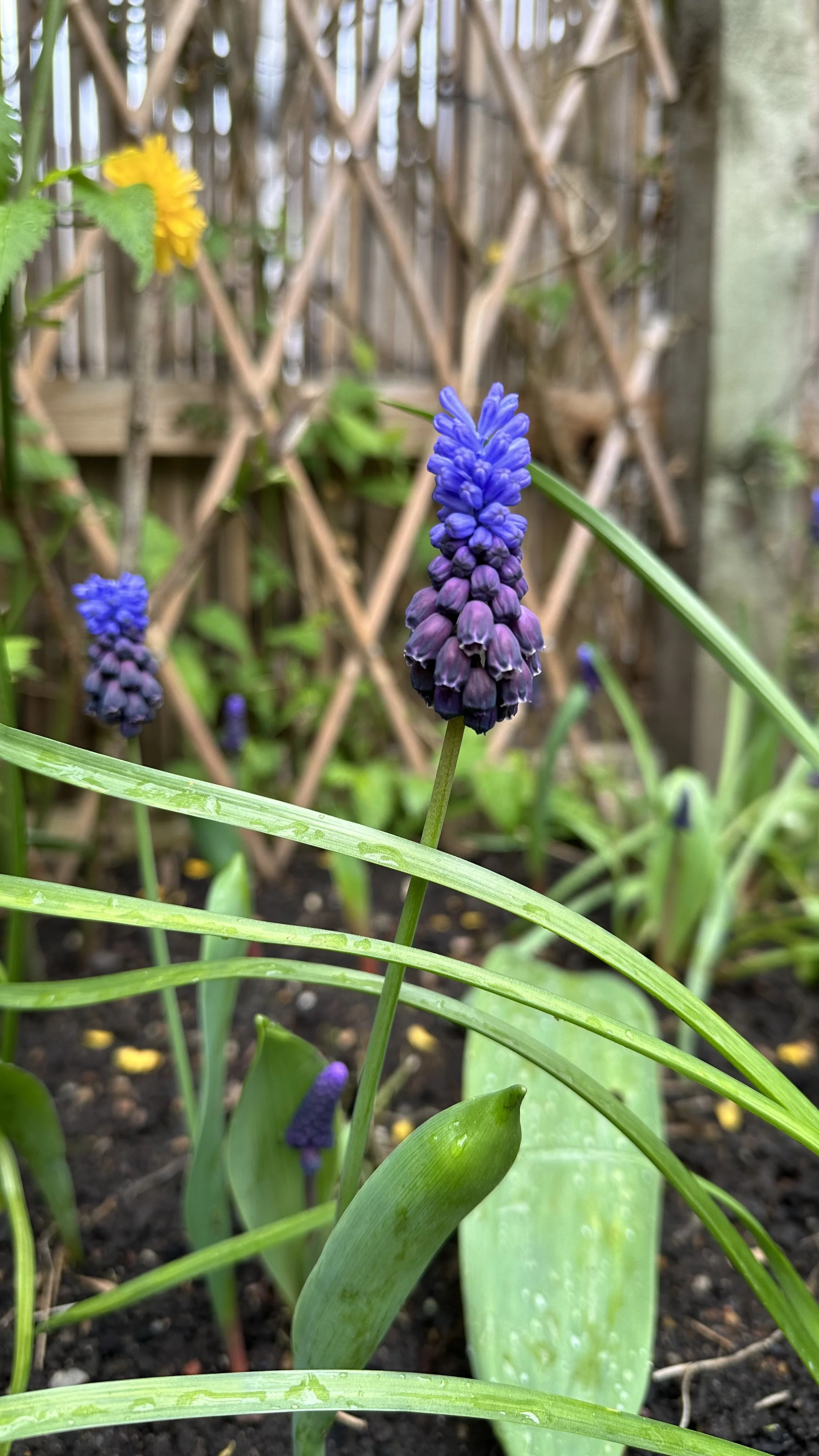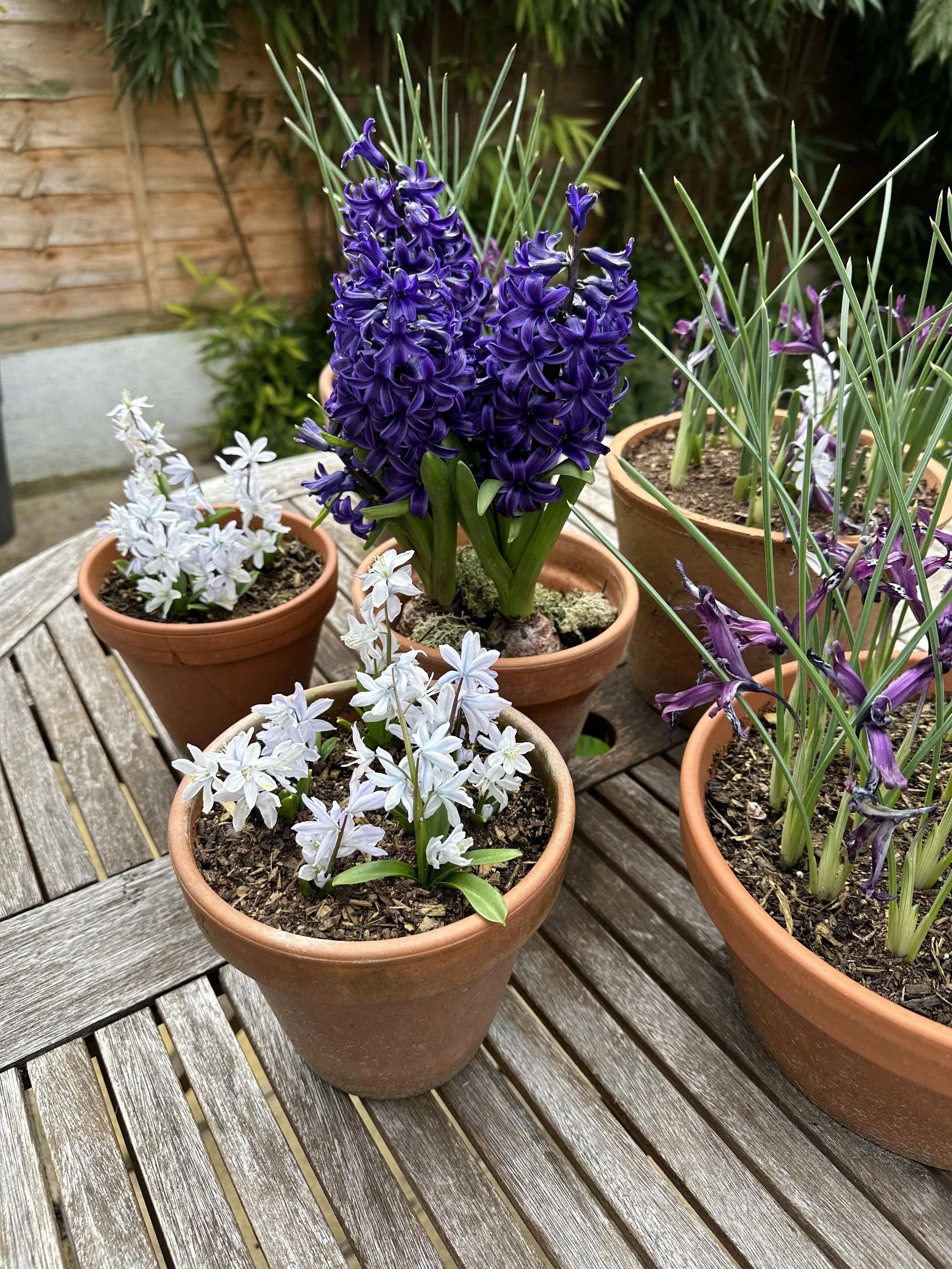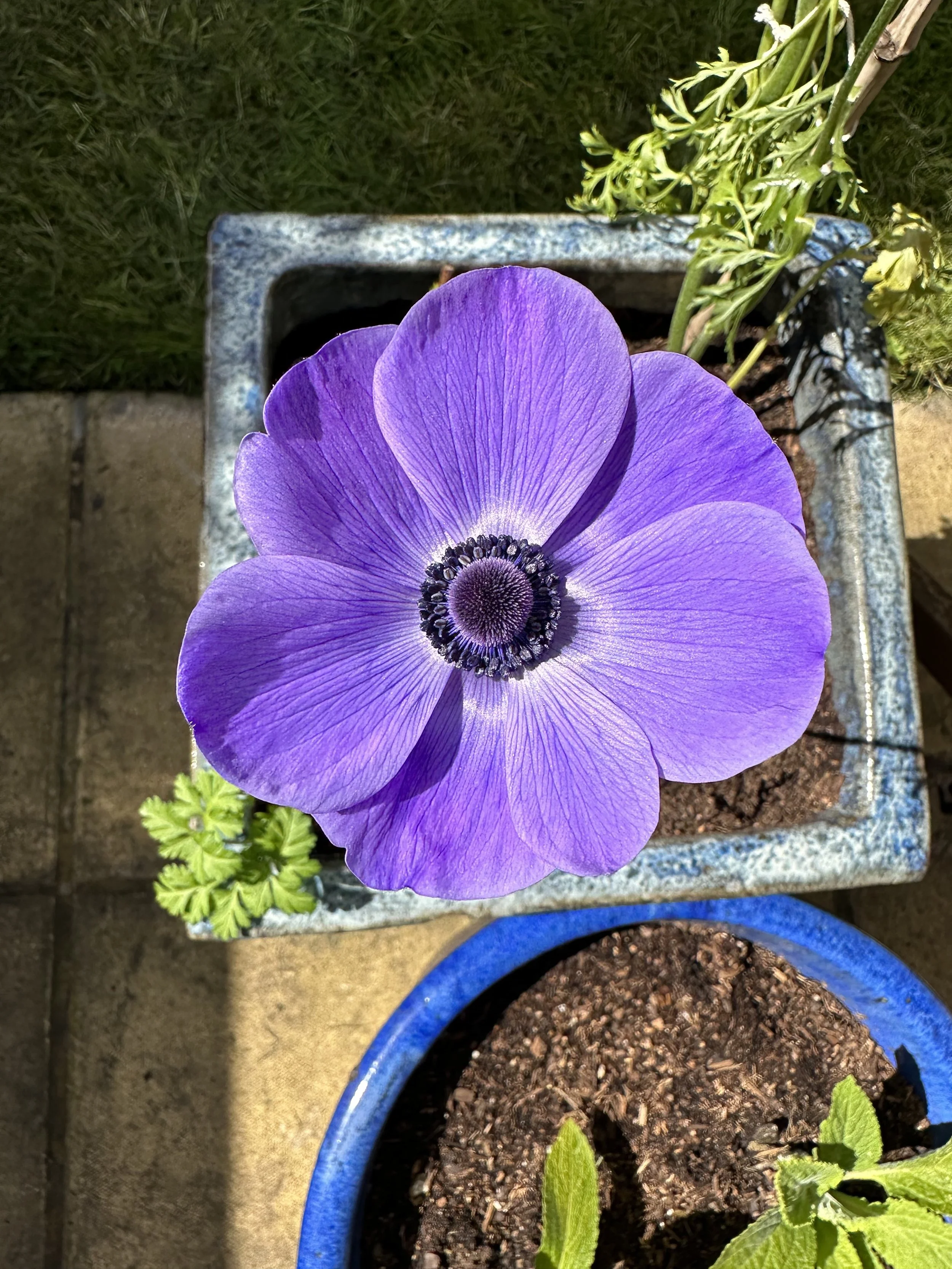Purple Spring Flowers for your Garden Design
This article has links to products that I may make commission from.
Purple is a rich, regal color that adds depth and elegance to any garden design.
One of the main benefits of adding purple spring flowers to your garden is their ability to create a sense of contrast.
Purple spring flowers are some of the first to bloom each year and will stand out against green foliage and can provide a beautiful visual contrast.
They can also be used to complement other colors in your garden, such as orange or yellow flowers, making your garden look more vibrant and colorful.
Their deep, rich hues are perfect for bringing spring interest to cottage gardens, wildflower meadows, or in more formal gardens.
There are many different types of purple spring flowers available so it's easy to find one that suits your specific gardening needs.
Here is my list of the best purple flowering blossoms for your garden.
To learn more about spring flowers, check out my guide:
Iris (Iris germanica)
The iris is a classic spring flower that comes in a wide variety of colors, including shades of purple.
With its tall, stately stems and large, showy blooms (some can be up to 6 inches wide), the iris is sure to make a statement in any garden.
Climate:
Irises prefer a cool, moist climate and can tolerate frost.
They can be grown in a wide range of climates, from cool temperate regions to hot and dry regions.
USDA Hardiness Zones 3-9.
Soil:
An iris grows well in soil that is rich in organic matter and is well drained.
They can be grown in a variety of soil types, including clay, loam, and sandy soils.
The pH should be between 6.0 and 7.0.
Sunlight:
Irises prefer full sun to partial shade.
They should be planted in a location that receives at least 6 hours of direct sunlight per day, such as a south-facing garden.
Water:
Irises prefer consistent moisture, but they should not be overwatered.
They should be watered deeply once a week, or more frequently during hot, dry weather.
Pruning:
Deadhead spent blooms after the iris has finished flowering to encourage the production of new blooms.
It is also recommended to divide the iris every 3-4 years in the fall or early spring to help maintain their health.
Disease:
Irises are susceptible to a variety of diseases, including iris borers, iris mosaic virus, and botrytis blight.
Proper care and sanitation can help prevent these diseases.
Pests:
Irises can be affected by pests such as aphids, thrips, spider mites, and slugs.
Regularly inspecting your plants and using appropriate control methods can help keep pests at bay.
My recommendation
Here are the irises I recommend growing:
For more garden tips, check out my guides:
Lilac (Syringa vulgaris)
Lilacs are a popular spring flower that are known for their sweet fragrance.
These delicate, purple flowers bloom from late spring to early summer and are perfect for adding a touch of elegance to any garden.
Climate:
Lilacs are hardy in USDA zones 3-7, and can tolerate cold winter temperatures and hot summers.
They thrive best in cool to temperate climates with moderate summers.
Soil:
Lilacs prefer well-drained, rich, and slightly acidic soil, with a pH between 5.5 and 7.5.
They tolerate a wide range of soil types, but they do not tolerate heavy clay soil or poor drainage.
Sunlight:
Lilacs prefer full sun, at least 6 hours of direct sunlight per day, but can tolerate light shade, like what can be found in a south-east facing garden.
Water:
Lilacs have moderate water requirements and should be watered regularly, especially during dry spells.
The soil should be kept consistently moist but not waterlogged.
Pruning:
Lilacs should be pruned immediately after blooming to encourage the growth of new buds for the next year.
Prune out dead, diseased or damaged wood, and remove any suckers (shoots that grow from the base of the plant) that appear.
Disease:
Lilacs are generally disease-free but can be affected by powdery mildew, leaf spot, and verticillium wilt.
Proper care and sanitation can help prevent these diseases.
Pests:
Lilacs can be affected by pests such as aphids, scale insects, and Japanese beetles.
Regularly inspecting your plants and using appropriate control methods can help keep pests at bay.
My recommendation
Here is the lilac I recommend growing:
Start your own cut flower garden with my guide:
Hyacinth (Hyacinthus orientalis)
Hyacinths are a favorite spring flower for their sweet fragrance and abundance of blooms.
They are bulbous perennials that come in a variety of colors, including shades of purple, and are perfect for adding a pop of color to any garden.
They are also known for being deer resistant. For a beautiful spring display, they look lovely in window boxes.
Climate:
Hyacinths are hardy in USDA zones 4-8, and can tolerate cold winter temperatures and cool to moderate spring temperatures.
They are best grown in cool to temperate climates with moderate summers.
Soil:
Hyacinths prefer well drained soil that is slightly acidic, with a pH between 5.5 and 7.5.
They can grow in a variety of soil types, but prefer a slightly sandy soil that is not waterlogged.
Learn more about growing hyacinths with my guide: Forcing Hyacinth Bulbs The Easy Way.
Sunlight:
Hyacinths prefer full sun to partial shade, but they need at least 6 hours of direct sunlight per day to perform well.
Water:
Hyacinths have moderate water requirements and should be watered regularly, especially during dry spells.
The soil should be kept consistently moist but not waterlogged.
Pruning:
After blooming, the flower stalk can be cut back to the base of the plant.
The leaves should be left to die back naturally, as they are needed to nourish the bulb for next year’s growth.
Disease:
Hyacinths are generally disease-free, but they can be affected by bulb rot, botrytis, and tulip fire, which are caused by over-watering, poor drainage and late planting. Proper care and sanitation can help prevent these diseases.
Pests:
Hyacinths can be affected by pests such as bulb mites, tulip bulb fly and tulip-eating nematodes.
Regularly inspecting your plants and using appropriate control methods can help keep pests at bay.
My recommendation
Here is the Hyacinth I recommend growing:
For more inspiration, check out my guides:
Tulip (Tulipa spp.)
Tulips are a classic spring flower that come in a wide variety of colors, including purple varieties.
These bulbous perennials have large, showy blooms are perfect for brightening the garden in spring.
Climate:
Tulips are hardy in USDA zones 3-8 and can tolerate cold winter temperatures and cool to moderate spring temperatures.
They are best grown in cool to temperate climates with moderate summers.
Soil:
Tulip are a plant type that prefer well-drained, rich soil that is slightly acidic, with a pH between 6.0 and 7.0.
They can grow in a variety of soil types, but prefer a slightly sandy soil that is not waterlogged.
Check out my guide: Container Color: Easy Steps to Growing Bulbs in Pots.
Sunlight:
Tulips prefer full sun to partial shade, but they need at least 6 hours of direct sunlight per day to perform well.
Also check out my guide to How Long Do Tulips Bloom?
Water:
Tulips have moderate water requirements and should be watered regularly, especially during dry spells.
The soil should be kept consistently moist but not waterlogged.
Pruning:
After blooming, the flower stalk can be cut back to the base of the plant.
The leaves should be left to die back naturally, as they are needed to nourish the bulb for next year's growth.
Disease:
Tulips can be affected by a variety of diseases, such as tulip fire, tulip breaking virus, and tulip mosaic virus.
Proper care and sanitation can help prevent these diseases.
Pests:
Tulips can be affected by pests such as tulip bulb mites, tulip-eating nematodes, and bulb flies.
Regularly inspecting your plants and using appropriate control methods can help keep pests at bay.
My recommendation
Here is the purple tulip variety I recommend growing:
purple Crocus flower (Crocus Spp.)
Crocuses are one of the earliest spring flowers to bloom, and their small, delicate blooms are a welcome sight after a long winter.
These purple perennials are a particularly lovely variety that is perfect for adding a touch of color to any garden.
Crocus typically have a bloom time of late winter to early spring.
For tips on planting crocus, check out my guide: When to Plant Crocus.
Also, check out my guide to The Top 3 Bulbs that Flower in Winter.
Climate:
Crocuses are hardy in USDA zones 3-8 and can tolerate cold winter temperatures and cool to moderate spring temperatures.
They are one of the first spring flowers to bloom and they are best grown in cool to temperate climates with moderate summers.
Soil:
Crocuses prefer well-drained, rich soil that is slightly acidic, with a pH between 6.0 and 7.0.
They can grow in a variety of soil types, but prefer a slightly sandy soil that is not waterlogged.
Sunlight:
Crocuses prefer full sun to partial shade, but they need at least 6 hours of direct sunlight per day to perform well.
Water:
Crocuses have moderate water requirements and should be watered regularly, especially during dry spells.
The soil should be kept consistently moist but not waterlogged.
Pruning:
After blooming, the flower stalk can be cut back to the base of the plant.
The leaves should be left to die back naturally, as they are needed to nourish the bulb for next year's growth.
Disease:
Crocuses are generally disease-free, but they can be affected by bulb rot, botrytis, and tulip fire, which are caused by over-watering, poor drainage and late planting.
Proper care and sanitation can help prevent these diseases.
Pests:
Crocuses can be affected by pests such as bulb mites, tulip bulb fly and tulip-eating nematodes.
Regularly inspecting your plants and using appropriate control methods can help keep pests at bay.
My recommendation
Here is the crocus variety I recommend:
Grape Hyacinth (Muscari armeniacum)
Grape hyacinths are a small, delicate spring flower that is perfect for adding a touch of color to any garden.
These tiny, purple blooms are one of my favorite things to grow.
Grape Hyacinth, also known as Muscari armeniacum, are bulbous perennial plants that are well suited for a variety of climates and soil types.
After planting they are relatively low maintenance perennial flowers.
Over time that can begin to spread and create an excellent spring ground cover.
Climate:
Grape Hyacinths are hardy in USDA zones 3-8 and can tolerate cold winter temperatures and cool to moderate spring temperatures.
They are best grown in cool to temperate climates with moderate summers.
Soil:
Grape Hyacinths prefer well-drained, rich soil that is slightly acidic, with a pH between 6.0 and 7.0.
They can grow in a variety of soil types, but prefer a slightly sandy soil that is not waterlogged.
Sunlight:
Grape Hyacinths prefer full sun to partial shade, but they need at least 6 hours of direct sunlight per day to perform well.
Water:
Grape Hyacinths have moderate water requirements and should be watered regularly, especially during dry spells.
The soil should be kept consistently moist but not waterlogged.
Pruning:
After blooming, the flower stalk can be cut back to the base of the plant.
The leaves should be left to die back naturally, as they are needed to nourish the bulb for next year's growth.
Disease:
Grape Hyacinths are generally disease-free, but they can be affected by bulb rot, botrytis, and tulip fire, which are caused by over-watering, poor drainage and late planting.
Proper care and sanitation can help prevent these diseases.
Pests:
Grape Hyacinths can be affected by pests such as bulb mites, tulip bulb fly and tulip-eating nematodes.
Regularly inspecting your plants and using appropriate control methods can help keep pests at bay.
My recommendation
Here is the Grape Hyacinth variety I recommend:
Scilla (Scilla spp.)
Scillas are a small, delicate spring flower that is perfect for adding color to the garden in spring.
Climate:
Scilla are hardy in USDA zones 3-8 and can tolerate cold winter temperatures and cool to moderate spring temperatures.
They are best grown in cool to temperate climates with moderate summers.
Soil:
Scilla prefer well-drained, rich soil that is slightly acidic, with a pH between 6.0 and 7.0.
They can grow in a variety of soil types, but prefer a slightly sandy soil that is not waterlogged.
Sunlight:
Scilla prefer full sun to partial shade, but they need at least 6 hours of direct sunlight per day to perform well.
Water:
Scilla have moderate water requirements and should be watered regularly, especially during dry spells.
The soil should be kept consistently moist but not waterlogged.
Pruning:
After blooming, the flower stalk can be cut back to the base of the plant.
The leaves should be left to die back naturally, as they are needed to nourish the bulb for next year's growth.
Disease:
Scilla are generally disease-free, but they can be affected by bulb rot, botrytis, and tulip fire, which are caused by over-watering, poor drainage and late planting.
Proper care and sanitation can help prevent these diseases.
Pests:
Scilla can be affected by pests such as bulb mites, tulip bulb fly and tulip-eating nematodes.
Regularly inspecting your plants and using appropriate control methods can help keep pests at bay.
My recommendation
Here is the Scilla I recommend:
Pansy (Viola x wittrockiana)
Pansies are a popular spring flower that come in a wide variety of colors, including shades of purple.
Climate:
Pansies are hardy in USDA zones 4-8 and are best grown in cool to temperate climates with moderate summers.
They can tolerate some frost and cool temperatures, but will not tolerate extreme heat.
Soil:
Pansies prefer well-drained, rich soil that is slightly acidic, with a pH between 6.0 and 7.0.
They can grow in a variety of soil types, but prefer a slightly sandy soil that is not waterlogged.
Sunlight:
Pansies prefer full sun to partial shade, but they need at least 4 hours of direct sunlight per day to perform well.
Water:
Pansies have moderate water requirements and should be watered regularly, especially during dry spells.
The soil should be kept consistently moist but not waterlogged.
Pruning:
After blooming, the dead flowers should be removed regularly to encourage re-blooming.
Pinch back the tips of the plants to encourage bushier growth.
Disease:
Pansies are generally disease-free, but they can be affected by fungal diseases such as powdery mildew, and root rot.
Proper care and sanitation can help prevent these diseases.
Pests:
Pansies can be affected by pests such as aphids, slugs and snails, and spider mites.
Regularly inspecting your plants and using appropriate control methods can help keep pests at bay.
My recommendation
Here are the pansies I recommend growing:
Anemone (Anemone spp.)
Anemones are a delicate spring flower that are stunning when they begin to blossom.
Climate:
Anemones are hardy in USDA zones 4-8 and can tolerate cold winter temperatures and cool to moderate spring temperatures.
They are best grown in cool to temperate climates with moderate summers.
Soil:
Anemones prefer well-drained, rich soil that is slightly acidic, with a pH between 6.0 and 7.0.
They can grow in a variety of soil types, but prefer a slightly sandy soil that is not waterlogged.
Sunlight:
Anemones prefer full sun to partial shade, but they need at least 4 hours of direct sunlight per day to perform well.
Water:
Anemones have moderate water requirements and should be watered regularly, especially during dry spells.
The soil should be kept consistently moist but not waterlogged.
Pruning:
After blooming, the dead flowers should be removed regularly to encourage re-blooming.
Cut back the foliage to the ground after it has died back in the fall.
Disease:
Anemones are generally disease-free, but they can be affected by fungal diseases such as powdery mildew, and root rot.
Proper care and sanitation can help prevent these diseases.
Pests:
Anemones can be affected by pests such as aphids, slugs and snails, and spider mites.
Regularly inspecting your plants and using appropriate control methods can help keep pests at bay.
Purple spring flowers are a great way to add color and beauty to your garden design.
These flowers are all easy to grow and maintain, making them the perfect addition to any garden.
Looking to add a pop of white to your garden as well with a white flowering tree this spring?
Check out our guide to White Spring Flowering Trees for your Garden Design.
Looking for more garden inspiration? Check out my other flower garden guides:
































